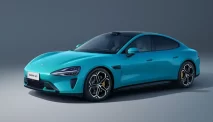Diksia.com - SEMARANG, Laksana Bodywork has successfully conducted a frontal crash test on a large bus using a simulation process using the parameters of Regulation No. of the United Nations Economic Commission for Europe. 29 or UN ECE R29 at their workshop in Ungaran, Central Java, today, Thursday 6 July 2023.
This crash test was attended by several bus operators who are customers of Karoseri Laksana, as well as officials from the Indonesian Ministry of Transport and the National Transport Safety Commission (NTSC).
A Karoseri Laksana crash test uses a model of a large Karoseri Laksana bus body, which is then hit from the front by a 1.5-ton pendulum to simulate a two-vehicle front-end collision and a goat fight. The driver puts a doll on the driver’s seat.
The test was conducted by impacting a thick steel pendulum weighing 1.5 tons on the front frame of the vehicle with an impact energy of 55 kJ and an impact speed of 8.56 m/s (31 km/h).
In order to pass this test, the driver’s safety area must be protected, which is then demonstrated by the presentation of a dummy that does not touch the structure.
A satisfactory result was obtained from the results of this collision. The frame structure of the bus body can save the driver from the risk of injury. The position of the driver’s legs is not pinched by the front of the body, as is often the case in head-on collisions on freeways or toll booths.
In addition, the frame structure of the front body of the bus is also able to protect the position of the core network from the danger of being stuck on the front body of the bus, because after this test, the front door of the bus can still be stuck open, too if no deformation occurs.
For the Laksana body, this front-end crash test will complement the various test results on the production bus body previously conducted with reference to United Nations Economic Commission for Europe (UNECE) safety regulations.
Standards for motor vehicles, especially buses and trucks, with regard to frontal impact protection.
These regulations focus on the safety of passengers and drivers of commercial vehicles by prescribing specific structures and components that vehicles must comply with to reduce the risk of serious injury in a frontal collision.
The benefit is to increase the bus operator’s confidence in the reliability of the bus body frame manufactured by Karoseri Laksana and ensure the safety of the bus staff and passengers in the event of a head-on collision on the highway.
“This safety test is important for us as a player in the transport industry in Indonesia. This activity demonstrates our commitment to improving the safety aspects of the buses we produce,” said Stefan Arman, Head of Body Engineering.
Stefan said that at every stage from development to production, we always prioritize passenger safety.
“With the government’s commitment to continue expanding toll roads in Indonesia, we are committed to continue developing buses that prioritize safety aspects with innovative exterior and interior design as well as passenger comfort. Our buses are ready to fill toll roads in Java, Sumatra and Sulawesi,” he said.
Director of Road Services, Department of Transport. Irish Danto Restyawan hopes that other bus body makers in Indonesia can follow in Laksana’s footsteps and improve the quality of their bus body products in order to increase the safety level for passengers and bus personnel.
“I hope it’s the same in all auto body industries,” he said.
The same was stated by the chairman of the National Road Safety Committee (KNKT), Soerjanto Tjahjono. He appreciates Karoseri Laksana’s innovations and updates, especially for its full commitment to ensuring the safety of passengers and drivers.
He said Laksana was the first bus body in Indonesia to apply the UN ECE R29 test standard.
“These innovations and improvements make Laksana a role model for other coachbuilders in the country.
“We hope that with this, other facilities will also follow the vehicle standards developed by Laksana to create safe and comfortable transportation for the community,” said Soerjanto Tjahjono.
Previously, Bas Laksana has undergone several tests and passed the European safety standards for bus travel, such as the UN ECE R66 and UN ECE R80 rolling tests for international standards from Europe to test the strength of bus seats and permanent bus seat holders. tied down when the bus has an accident. .
Laksana also passed the stability test of a bus moving on an inclined road with a minimum angle of 28 degrees without the bus body rolling according to the UN-ECE-R107 standard and passed the UN-ECE-R93 test for the front Underrun Protection Device (FUDP) construction in which the material can withstand a load of up to 160 kN.
UN ECE R93 prevents a small vehicle such as a sedan from driving under the bus if it collides head-on with the bus.
Stefan added that since its establishment 46 years ago, Karoseri Laksana has continuously innovated to present a high quality, innovative and safe means of transportation.
“We are grateful to the Department of Transportation and the NTSC for their continued support in improving road safety,” he added.
Various UN-ECE test results will make it easier for the body industry to handle the bus export market to different countries in the future.
According to Kusriri, R&D manager at Laksana Carrosserie, his company has exported several premium Legacy SR2 model buses to Bangladesh and around 200 aluminum-bodied buses to the Republic of Fiji in the Pacific Islands.
Source: Tribunnews, Choirul Arifin






